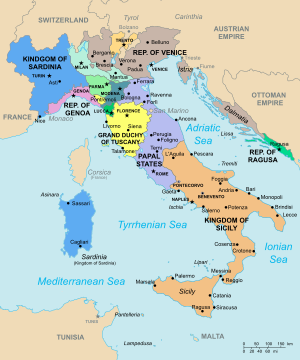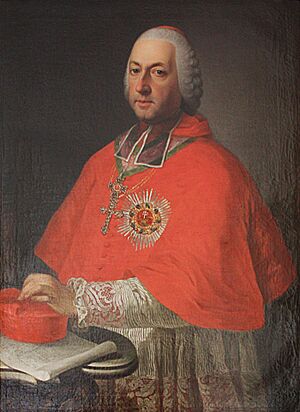Treaty of Aranjuez (1752) facts for kids

18th century Italy; note Kingdom of Sardinia; main Spanish possessions Kingdom of Sicily and Parma; main Austrian possessions Tuscany and Milan
|
|
| Context | Austria, Spain and Sardinia |
|---|---|
| Signed | 14 June 1752 |
| Location | Aranjuez |
| Negotiators |
|
| Parties | |
The Treaty of Aranjuez (1752) was an important agreement signed on June 14, 1752. It involved three major European powers: Austria, Spain, and the Kingdom of Sardinia. A treaty is like a formal agreement or contract between countries.
This treaty aimed to keep peace in Italy. It made sure that the borders of these countries in Italy, which were decided in an earlier agreement called the Treaty of Aix-la-Chapelle, would be respected. Britain helped to arrange this treaty. Britain hoped it would make Spain less friendly with France.
Even though things changed a few years later with the "Diplomatic Revolution" (where Austria became allies with France instead of Britain), this treaty successfully stopped conflicts in Italy for over 40 years.
Contents
Why Was the Treaty of Aranjuez Needed?
Before this treaty, there was a big war called the War of the Austrian Succession. During this war, Austria and Sardinia fought against Spain for control of Northern Italy. When the war ended in 1748 with the Treaty of Aix-la-Chapelle, Austria gave some land to Sardinia and Spain. However, both Sardinia and Spain felt they didn't get enough.
In Spain, a new king, Ferdinand VI, took over in 1746. He was more open to working with Britain than the previous king. Britain's goal was to make France less powerful by getting Spain to join an alliance against France. So, British diplomats worked hard to bring Spain and Austria closer together.
King Ferdinand's wife, Barbara of Portugal, was a cousin of the Austrian Empress Maria Theresa. She also wanted Austria and Spain to have a better relationship. In 1751, Austria suggested that Spain and Austria should promise to protect the Italian borders agreed upon in 1748. The British Ambassador to Spain, Sir Benjamin Keene, thought Sardinia and Britain should also be part of this agreement.
Empress Maria Theresa really wanted to get back Silesia, a region she lost to Prussia in 1745. Making peace in Italy would allow her to focus on fighting Prussia. So, she agreed to include Sardinia in the treaty. However, she was not happy about the land she had to give up in 1748 because Britain pushed for it.
Sardinia's ruler, Charles Emmanuel III of Sardinia, was also unhappy with the land he received. He didn't want to join a treaty that guaranteed those borders. Eventually, he agreed to send a representative, Count St Marsan, to Madrid. But he refused to talk directly with Austria. This meant that much of the negotiation was done by Spain's foreign minister, José de Carvajal y Lancáster, with help from the British ambassador, Benjamin Keene.
What Did the Treaty of Aranjuez Say?
Even though the main ideas of the treaty were simple, the negotiations took a long time because of arguments about how things should be done. For example, Sardinia wanted its representative to sign the treaty first to show that all countries were equal. But Spain and Austria disagreed.
The Kingdom of Sardinia included land on the mainland (Piedmont) and the island of Sardinia. Austria's Empress Maria Theresa argued that because Austria didn't have a navy, she couldn't protect Sardinia's island borders. But Sardinia refused to sign unless she promised to protect all its borders.
There was another delay when the Austrian negotiator, Esterhazy, got sick and was replaced by Count Migazzi. On April 10, Austria and Spain signed a first version of the treaty. It was only because of Ambassador Keene's strong efforts that discussions about adding Sardinia continued. Finally, Spain added a secret part to the treaty. It said Spain would help transport Austrian troops to defend Sardinia if needed. With this, the treaty was finally signed on June 14, 1752.
The treaty included a promise for mutual defense. This meant that if any other country tried to change the agreed-upon borders, the three countries would help each other. It also said that all three countries would give "most favored nation" trading status to each other's citizens. This meant they would offer the best trade conditions to each other.
What Happened After the Treaty?
The Treaty of Aranjuez aimed to bring lasting peace to Italy. Spain had made a promise on behalf of the Kingdom of Naples, which was ruled by King Ferdinand's half-brother, Charles. However, Charles refused to agree to the treaty, which weakened it from the start.
More importantly, Britain's plan to separate Spain from France didn't work out. In 1756, a major shift happened in European politics called the "Diplomatic Revolution". Austria and France, who had been enemies for centuries, suddenly became allies.
King Ferdinand VI of Spain died in 1759. His half-brother Charles became the new King of Spain. Charles then made his son, Ferdinand I, the King of Naples. Because of these changes and the new alliances, Italy became a less important place in European politics for the next forty years.
Sources
See also
 In Spanish: Tratado de Aranjuez (1752) para niños
In Spanish: Tratado de Aranjuez (1752) para niños



